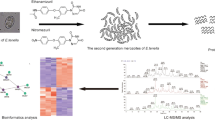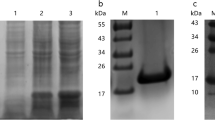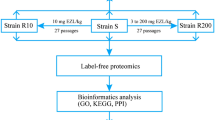Abstract
Diclazuril has long been used as an effective benzeneacetonitrile anticoccidial for the control of Eimeria tenella that causes coccidiosis. However, the molecular mechanism underlying the anticoccidial effects of diclazuril remains elusive. In this study, a proteomic analysis of the effect of diclazuril on second-generation merozoites of E. tenella was performed. Using two-dimensional gel electrophoresis and real-time quantitative polymerase chain reaction (RT-PCR), 13 target proteins were found to be significantly affected by diclazuril treatment, with 11 of these proteins being identified as annotated proteins from E. tenella or other Apicomplexa parasites. These proteins contribute to various functions, including metabolism, protein synthesis, and host cell invasion. Using RT-PCR, we identified the potential pattern of transcriptional regulation induced by diclazuril, and we suggest some promising targets for the intervention of E. tenella infection.


Similar content being viewed by others
References
Alvarez RA, Blaylock MW, Baseman JB (2003) Surface localized glyceraldehyde-3-phosphate dehydrogenase of Mycoplasma genitalium binds mucin. Mol Microbiol 48:1417–1425
Bradford MM (1976) Rapid and sensitive method for the quantitation of microgram quantities of protein utilizing the principle of protein-dye binding. Anal Biochem 72:248–254
Conway DP, Mathis GF, Johnson J, Schwartz M, Baldwin C (2001) Efficacy of diclazuril in comparison with chemical and ionophorous anticoccidials against Eimeria spp. in broiler chickens in floor pens. Poult Sci 80:426–430
Dalloul RA, Lillehoj HS (2006) Poultry coccidiosis: recent advancement in control measures and vaccine development. Expert Rev Vaccines 5:143–163
Dastoor Z, Dreyer J-L (2001) Potential role of nuclear translocation of glyceraldehyde-3-phosphate dehydrogenase in apoptosis and oxidative stress. J Cell Sci 114:1643–1653
De Furtado GC, Cao Y, Joiner K (1992) Laminin on Toxoplasma gondii mediates parasite binding to the β1 integrin receptor α6β1 on human foreskin fibroblasts and Chinese hamster ovary cells. Infect Immun 60:4925–4931
De Rocher AE, Coppens I, Karnataki A, Gilbert LA, Rome ME, Feagin JE, Bradley PJ, Parsons M (2008) A thioredoxin family protein of the apicoplast periphery identifies abundant candidate transport vesicles in Toxoplasma gondii. Eukaryot Cell 7:1518–1529
De Venevelles P, Chich JF, Faigle W, Loew D, Labbe’ M, Girard-Misguich F, Pe’ry P (2004) Towards a reference map of Eimeria tenella sporozoite proteins by two-dimensional electrophoresis and mass spectrometry. Int J Parasitol 34:1321–1331
De Venevelles P, Chich JF, Faigle W, Lombard B, Leow D, Pe’ry P, Labbe’ M (2006) Study of proteins associated with the Eimeria tenella refractile body by a proteomic approach. Int J Parasitol 36:1399–1407
Del Cacho E, Pagés M, Gallego M, Barbero JJ, Monteagudo L, Sánchez-Acedo C (2010) Meiotic chromosome pairing and bouquet formation during Eimeria tenella sporulation. Int J Parasitol 40:453–462
Flores MJ, Bidnenko V, Michel B (2004) The DNA repair helicase UvrD is essential for replication fork reversal in replication mutants. EMBO Rep 5:983–988
Hirayama K, Okamoto M, Sako T, Kihara K, Okai K, Taharaguchi S, Yoshino T, Taniyama H (2002) Eimeria organisms develop in the epithelial cells of equine small intestine. Vet Pathol 39:505–508
Labbe’ M, Pe’roval M, Bourdieu C, Girard-Misguich F, Pe’ry P (2006) Eimeria tenella enolase and pyruvate kinase: a likely role in glycolysis and in other functions. Int J Parasitol 36:1443–1452
Lal K, Bromley E, Oakes R, Prieto JH, Sanderson SJ, Kurian D, Hunt L, Yates JR III, Wastling JM, Sinden RE, Tomley FM (2009) Proteomic comparison of four Eimeria tenella life-cycle stage: unsporulated oocyst, sporulated oocyst, sporozoite and second-generation merozoite. Proteomics 9:4566–4576
Liu L, Xu L, Yan F, Yan R, Song X, Li X (2009) Immunoproteomic analysis of the second generation merozoite proteins of Eimeria tenella. Vet Parasitol 164:173–182
Livak KJ, Schmittgen TD (2001) Analysis of relative gene expression data using real-time quantitative PCR and the 2(-Delta Delta C (T)). Method 25:402–408
Madureira P, Baptista M, Vieira M, Magalhaes V, Camelo A, Oliveira L, Ribeiro A, Tavares D, Trieu-Cuot P, Vilanova M, Ferreira P (2007) Streptococcus agalactiae GAPDH is a virulence-associated immunomodulatory protein. J Immunol 178:1379–1387
Maes L, Coussement W, Vanparijs O, Marsboom R (1988) In vivo action of the anticoccidial diclazuril (Clinacox®) on the developmental stages of Eimeria tenella: a histological study. J Parasitol 74:931–938
Morahan BJ, Wang L, Coppel R (2008) No trap, no invasion. Trends Parasitol 25:77–84
Nodeh H, Mansoori B, Rahbari S, Modirsanei M, Aparnak P (2008) Assessing the effect of diclazuril on the intestinal absorptive capacity of broilers infected with experimental coccidiosis, using D-xylose absorption test. J Vet Pharmacol Ther 31:265–267
Ono S (2007) Mechanism of deploymerization and severing of actin filaments and its significance in cytoskeletal dynamics. Int Rev Cytol 258:1–82
Pellérdy L (1970) Life cycles involving sexual and asexual generations of Eimeria in gallinaceous birds. Parasit Hung 44:133–146
Rahlfs S, Schirmer RH, Becker K (2002) The thioredoxin system of Plasmodium falciparum and other parasites. Cell Mol Life Sci 59:1024–1041
Song H, Song X, Xu L, Yan R, Shah MAA, Li X (2010) Changes of cytokines and IgG antibody in chickens vaccinated with DNA vaccines encoding Eimeria acervulina lactate dehydrogenase. Vet Parasitol 173:219–227
Vanparijs O, Marsboom R, Hermans L, Van der Flaes L (1990) Diclazuril, a new broad-spectrum anticoccidials for chickens.3. Floor-pen trials. Poult Sci 69:60–64
Zhou BH, Wang HW, Wang XY, Zhang LF, Zhang KY, Xue FQ (2010) Eimeria tenella: effect of diclazuril treatment on microneme genes expression in second-generation merozoites and pathological changes of caeca in parasitized chickens. Exp Parasitol 125:264–265
Acknowledgments
We gratefully acknowledge Professor Jiaojiao Lin of Shanghai Veterinary Research Institute for technical support. This work was supported by the National Natural Science Foundation (grant numbers 31101857, 31072173, 31272607) and Shanghai Natural Science Foundation (11ZR1446300).
Author information
Authors and Affiliations
Corresponding author
Additional information
Xiao-jiong Shen and Tao Li contributed equally to this work.
Rights and permissions
About this article
Cite this article
Shen, Xj., Li, T., Fu, Jj. et al. Proteomic analysis of the effect of diclazuril on second-generation merozoites of Eimeria tenella . Parasitol Res 113, 903–909 (2014). https://doi.org/10.1007/s00436-013-3721-8
Received:
Accepted:
Published:
Issue Date:
DOI: https://doi.org/10.1007/s00436-013-3721-8




